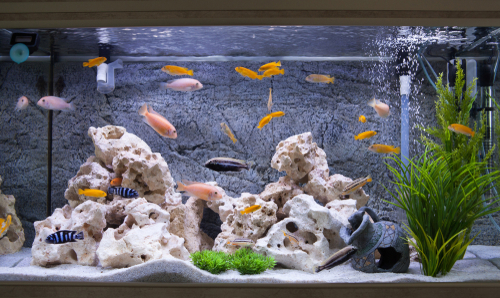Setting up an aquarium for cichlids, one of the most vibrant and dynamic fish species, can be both exciting and challenging. Their unique behaviors and territorial nature demand a thoughtful approach when it comes to decor. In this comprehensive guide, we’ll explore everything you need to know about aquarium decor for cichlids – from choosing the right substrate and plants to incorporating rocks and hiding spots that cater to their natural instincts.
Understanding Cichlids: Why Decor Matters
Cichlids are known for their bright colors and interesting behaviors. A well-decorated aquarium not only enhances their beauty but also provides essential environments that mimic their natural habitats. This helps reduce stress and promotes healthier living conditions.
The Natural Habitat of Cichlids
Cichlids are found in various aquatic environments, from African rift lakes to Amazonian rivers. Depending on their origin, they may thrive in rocky substrates, dense vegetation, or sandy bottoms. Understanding their natural habitat will guide your decor choices.

Key Features of a Cichlid’s Natural Environment
- Rock formations and caves for hiding
- Plants to provide cover
- A varied substrate that encourages digging
- Open swimming areas

Choosing the Right Substrate for Cichlids
The substrate you choose plays a pivotal role in your aquarium’s overall ecosystem. Let’s look at the most common types of substrates and their pros and cons.

| Substrate Type | Pros | Cons |
|---|---|---|
| Sandy Substrate | Gentle on fish; good for digging | Can stir up easily; may require regular cleaning |
| Gravel Substrate | Variety of colors; good for water circulation | Can be harsh for digging fish; may trap debris |
| Cichlid-Specific Substrate | Contains minerals beneficial for African cichlids | More expensive; may require buffering |
Recommended Substrates

My personal favorite is sandy substrate, especially for African cichlids. Not only does it mimic their natural habitat, but it also suits their digging behaviors perfectly. A 3-5 inch layer is ideal, allowing them to create their own spaces.
Plants for Cichlid Aquariums: Choosing the Right Greenery

Adding live plants to your aquarium offers numerous benefits, including improved water quality, oxygenation, and aesthetic appeal. However, not all plants are suitable for cichlids, as many are known for uprooting or nibbling on greenery.
Best Plants for Cichlid Tanks

| Plant Name | Benefits | Care Level |
|---|---|---|
| Anubias | Hardy, resistant to uprooting | Easy |
| Java Fern | Thrives in low light, attached to rocks | Easy |
| Amazon Sword | Great for background, requires nutrients | Moderate |
| Cryptocoryne | Variety of colors and shapes | Moderate |
Tips for Planting in Cichlid Tanks

- Choose hardy varieties that can withstand disturbances.
- Plant in groups to create a natural look.
- Use weights to keep smaller plants down.
Rocks and Caves: Creating a Natural Environment
Rocks and caves are essential for providing hiding spots and establishing territories. Cichlids love to explore and claim areas of their tank as their own.
Types of Rocks Suitable for Cichlid Tanks
| Rock Type | Pros | Cons |
|---|---|---|
| Slate | Easy to stack; offers flat surfaces | Can be sharp; check for safe edges |
| Lava Rock | Pore structure improves filtration | Heavy; may raise pH levels |
| Seiryu Stone | Aesthetically pleasing; natural look | More expensive; can alter water chemistry |
Building Caves
Creating caves can be as simple as stacking rocks in a way that provides overhangs and tunnels. It’s essential to ensure that the structures are stable to prevent them from collapsing, which could harm your fish.
Incorporating Other Decor: Driftwood and Ornaments
Driftwood can add a beautiful, natural touch to your aquarium while also providing additional hiding spots for your fish. However, it’s important to choose wood that won’t leach harmful substances into the water.
Best Driftwood Choices for Cichlid Tanks
- Malaysian Driftwood
- Mopani Wood
- Redmoor Root
Ornaments and Other Decor
When considering ornaments, look for those that are aquarium-safe and won’t leach chemicals. Decorative caves, sunken ships, and natural stone replicas can provide visual interest while serving practical purposes.
Maintaining Your Cichlid Aquarium Decor
Maintaining the decor in your cichlid aquarium is crucial for fish health and the overall appearance of your tank. Regular cleaning, monitoring water parameters, and ensuring that decor is safe and stable are vital steps.
Cleaning Tips
- Use a soft brush to clean rocks and decor during water changes.
- Avoid soaps or chemicals; rinse decor thoroughly with hot water.
- Inspect decor regularly for signs of wear or leaching.
FAQs about Aquarium Decor for Cichlids
What type of substrate is best for cichlids?
The best substrate for cichlids is sandy or cichlid-specific substrates that allow for digging and mimic their natural habitat.
Can I use plastic plants in a cichlid tank?
While plastic plants are an option, they don’t provide the benefits of live plants. If you choose plastic, ensure they are smooth to prevent injury to your fish.
Do cichlids need hiding spots?
Yes, cichlids thrive in environments with hiding spots and territories. Providing rocks and caves is essential for their well-being.
Are there any plants I should avoid with cichlids?
Avoid delicate plants like Water Sprite or Cabomba, as cichlids are known to uproot or nibble on them.
How often should I rearrange aquarium decor?
Rearranging decor isn’t necessary unless you notice aggressive behavior or overcrowding. It’s best to maintain stability in their environment.
Conclusion: Crafting a Beautiful Cichlid Habitat
Decorating your cichlid aquarium is a rewarding endeavor that enhances not only the aesthetic appeal but also the health and happiness of your fish. By choosing the right substrate, plants, rocks, and additional decor, you’ll create a vibrant environment that mimics their natural habitat. Remember, each cichlid species may have specific needs, so always consider their behavior and habitat preferences when setting up your aquarium. Happy fish-keeping!